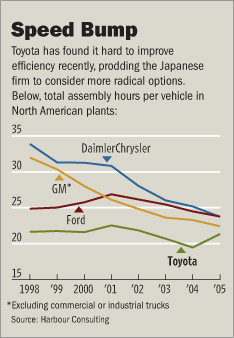 Source of graph: online version of WSJ article cited below.
Source of graph: online version of WSJ article cited below.
(p. A1) TOYOTA CITY, Japan — The world sees Toyota Motor Corp. as an unstoppable profit juggernaut, overtaking rivals one by one as it rolls toward replacing General Motors Corp. as the world’s largest auto maker.
Not Katsuaki Watanabe. Toyota’s chief executive officer is a worried man. He thinks Toyota is losing its competitive edge as it expands around the world. He frets that quality, the foundation of its U.S. success, is slipping. He grouses that Toyota’s factories and engineering practices aren’t efficient enough. Within the company, he has even questioned a core tenet of Toyota’s corporate culture — kaizen, the relentless focus on incremental improvement.
U.S. and European car makers have spent years struggling to overhaul outdated operations and work practices to better compete with Toyota. By some measures, some of those companies are catching up. Now, driven by a severe dose of institutional paranoia, Mr. Watanabe is trying to move the target.
Mr. Watanabe, 64 years old, wants kakushin, or revolutionary change in how Toyota designs cars and factories. He is pushing Toyota to reduce the number of components it uses in a typical vehicle by half — a radical idea that would usher in a new chapter in car design. He also wants to create new fast and flexible plants to assemble these simplified cars.
For the full story, see:
(I thank Aaron Brown for bringing this article to my attention.)
